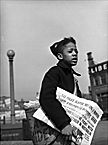| Entries |
| C |
|
Chicago Defender
|

|
The Defender remains most significant for the active part it played in the Great Migration. Most southern migrants got their first glimpse of life in Chicago in the pages of the Defender, glimpses that made the city a striking symbol of the migration even for those moving elsewhere. Setting departure dates and showing pictures of the best schools, parks, and houses in Chicago next to pictures of the worst conditions in the South, the Defender stirred migration fever across much of the South. Southern cities banned the newspaper and exacted serious penalties on anyone found distributing or reading it.

|
Bibliography
Green, Adam Paul. “Selling the Race: Cultural Production and Notions of Community in Black Chicago, 1940–1955.” Ph.D. diss., Yale University, 1998.
Grossman, James R.
Land of Hope: Chicago, Black Southerners, and the Great Migration.
1989.
Ottley, Roi.
The Lonely Warrior: The Life and Times of Robert S. Abbott.
1955.
The Electronic Encyclopedia of Chicago © 2005 Chicago Historical Society.
The Encyclopedia of Chicago © 2004 The Newberry Library. All Rights Reserved. Portions are copyrighted by other institutions and individuals. Additional information on copyright and permissions.
The Encyclopedia of Chicago © 2004 The Newberry Library. All Rights Reserved. Portions are copyrighted by other institutions and individuals. Additional information on copyright and permissions.